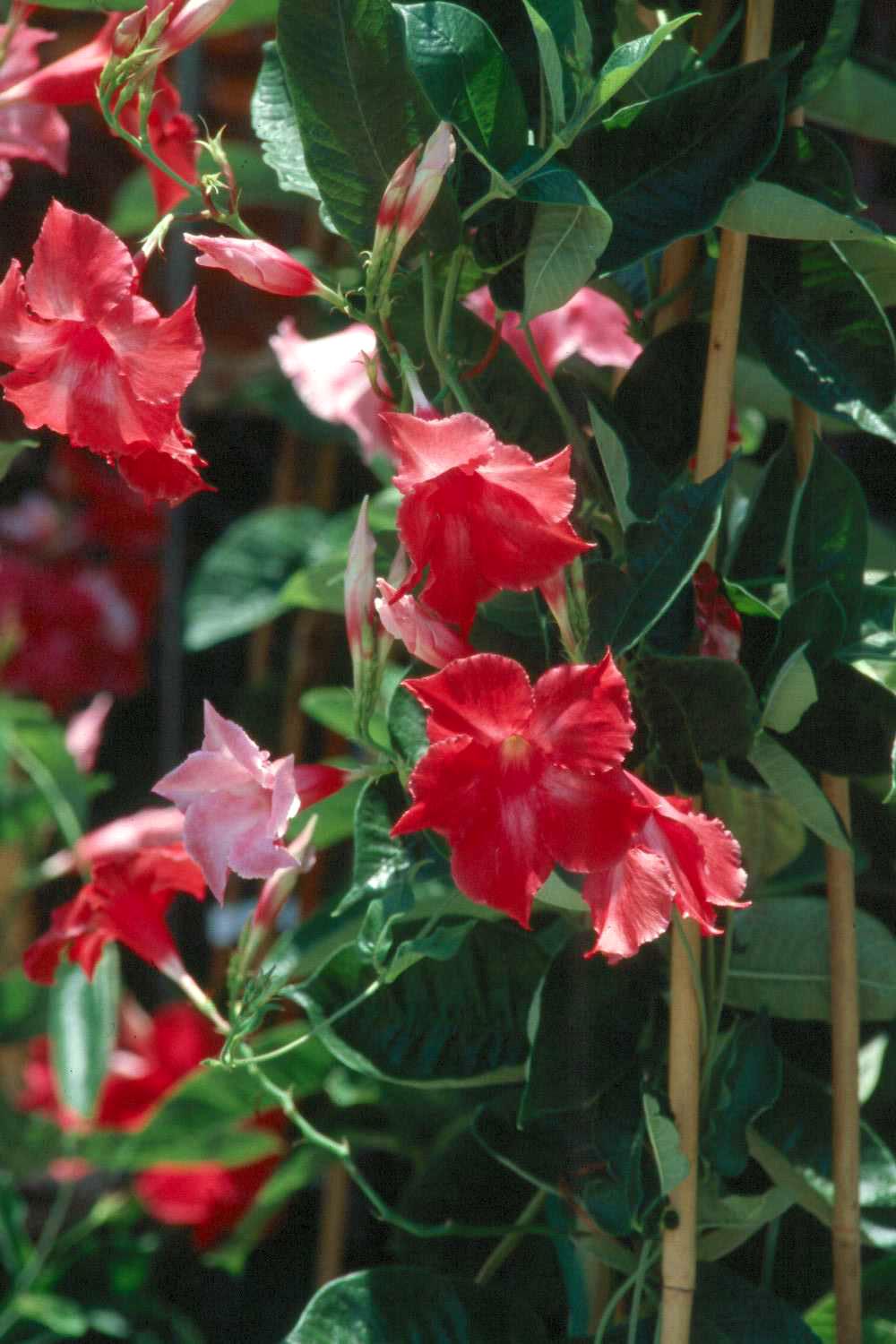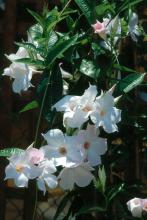Information Possibly Outdated
The information presented on this page was originally released on June 9, 2003. It may not be outdated, but please search our site for more current information. If you plan to quote or reference this information in a publication, please check with the Extension specialist or author before proceeding.
Tropical flowering vines provide color until frost
By Norman Winter
MSU Horticulturist
Central Mississippi Research & Extension Center
Many gardeners want plants that will bloom all summer and right up until fall. The first option always seems to be New Gold lantana. Believe it or not, there is a tropical vine that will bloom until the first freeze as well. It is called Brazilian Jasmine, or Mandevilla.
As the common name suggests, Mandevilla is from Brazil, but at the garden center you will get the feeling it is one of the locals. It is related to the Allamanda vine with its yellow, bell-shaped flowers, and to plumeria, the flowers that make up Hawaiian leis.
For years, the most popular variety has been Alice du Pont with its loads of large, pink, bell-shaped flowers on a vigorous vine. The dark, glossy leaves have a leathery feel. If you have seen a big, pink-flowered vine growing up a neighbor's mailbox, this was probably the plant.
I suspect that Alice du Pont will find tough competition this year and in the near future. There are two new red varieties: Best Red and my favorite, Ruby Star. The Best Red starts out red and ends up looking closer in color to Alice du Pont. The Ruby Star has pointed petals and maintains its red color much better. Both are great plants.
Those of you who like white with a blush of pink will love White Delight or Monte. These also have pointed petals and are every bit as vigorous as Alice du Pont.
Those looking for the truly fancy will want to look for Pink Parfait. This is a very large double-flowered (or rose form) Mandevilla with the same pink as Alice du Pont. The vine is vigorous and the flowers exquisite, but there will be fewer flowers because they are double-form.
As with almost every other plant I write about, it needs well-drained soil or it will die. For best flowering, you will want your Mandevilla to receive at least six to eight hours of sunlight a day. Full sunlight is better.
Since it is such a vigorous vine and flower producer, it needs small doses of fertilizer every two to three weeks. Use a balanced, water-soluble fertilizer or time-release granules. Maintain moisture during the hot, dry summer. A prolonged period without water may prove fatal to the plant.
Try growing a Mandevilla planted in a large hanging basket, and let it climb the long chains. A tri-color ornamental sweet potato flowing out of the basket in all directions will help set off the Mandevilla.
Try intertwining the Mandevilla with the iridescent blue-flowered clematis. This mixture of Southern perennial and Brazilian tropical is bold and spectacular.
If you have lattice structures around the house, the Mandevilla is a must. Its ability to climb and bloom until fall makes it a champion. Being a tropical from Brazil means that gardeners on the Coast -- probably south of I-10 -- can get it to establish permanently. The rest of us will either have to treat it as an annual or give it winter protection.
Before bringing it indoors, cut off all growth to make it the desired shape. It will not bloom indoors unless it is in a sunroom. Our goal is simply to hold the plant until the next planting season.
Another method, and probably the easiest for most of us, is to cut it back to about 6 inches, provide as bright a light as possible and minimal water. Do not fertilize during this time. As the plant grows, keep it pinched back to leaf-axis so it will develop a bushy habit. In the spring, repot or plant in the landscape and resume the fertilization program.
Tropical plants offer some of the best options for plants with five or six months of continuous bloom, and Mandevilla has to be at the top of that list.




